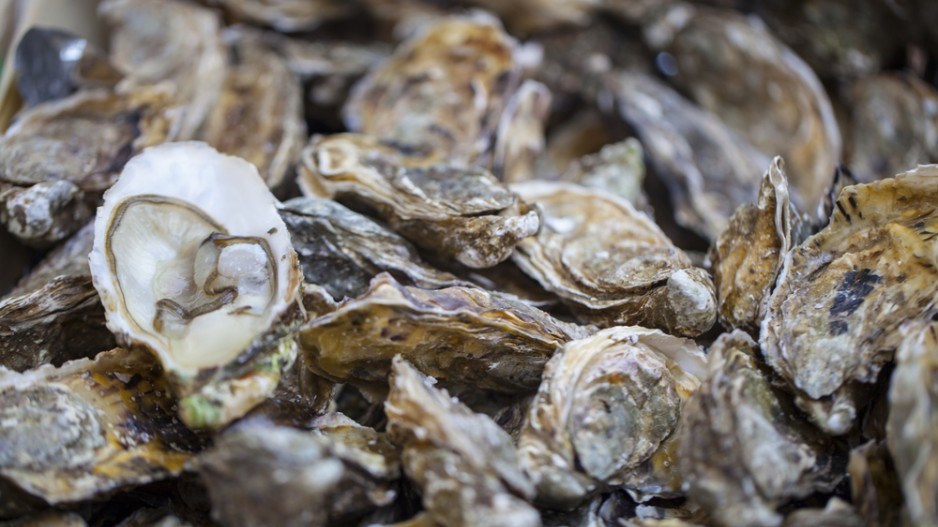Human beings ate more seafood in 2016 than ever before, and as the world’s population grows, the best thing they can do for the environment is to eat even more.
That’s according to the United Nations’ State of World Fisheries and Aquaculture report, which recommends both farmed and wild seafood as the best source of protein for a growing population.
Coinciding with that report, a new study published in Frontiers in Ecology and the Environment identifies wild fish and farmed seafood – including farmed salmon – as a protein source with a much lower environmental footprint than chicken, pork and beef.
For that reason, Don Noakes, former director for the Pacific Biological Station, is urging provincial and federal governments in Canada to capitalize on its vast coastlines, rivers and lakes to dramatically increase Canada’s production of farmed seafood.
According to the UN report, there was a record production of seafood in 2016: 171 million tonnes. Nearly half – 46% – was from aquaculture. That’s up from 25.7% in 2000.
“Since the 1980s, virtually all of the increase in the amount of fish consumed has come from aquaculture, which has outpaced population growth and become the world’s fastest-growing food production industry,” the UN report states.
“The fisheries and aquaculture sector is crucial to improving food security and human nutrition and has an increasingly important role in the fight against hunger.”
About one-third of the world’s capture fisheries are fished at unsustainable levels, the UN report points out. The good news is that, in developed nations, wild fisheries are generally fished at sustainable levels and, in some cases, have been growing in abundance.
But the oceans’ ability to produce wild fish is finite, so many species are already harvested at sustainable, albeit maximized, levels.
“There’s really very little potential growth in capture fisheries,” said Ray Hilborn, a professor at the University of Washington’s School of Aquatic and Fishery Sciences and lead author of the recent Frontiers in Ecology study.
“But there’s enormous potential growth in aquaculture, and it’s happening. The interesting thing is it’s not happening much in the U.S. and Canada.”
With more than 70,000 kilometres of marine coastline, Canada could dramatically increase seafood production, Noakes says in a new report, Oceans of Opportunity.
“The world’s population is expected to increase by 30% to 10 [billion] people by 2050 and with 70% of the earth’s surface covered by water, aquaculture will play an important role in producing food for the future,” Noakes’ report concludes.
Asia is the largest producer of farmed seafood, with China being the single largest producer. Despite its size and vast coastlines, Canada is a relatively small seafood producer.
“We have the longest coastline in the world by far,” Noakes said. “We’re probably at the bottom – or close to the bottom – in terms of the amount of area in the ocean that we use for aquaculture … so there’s certainly huge opportunities.”
In his assessment of animal protein, Hilborn considered environmental impacts, such as energy use, greenhouse gas emissions and the use of – and impacts on – water and land. He concluded that, from an environmental standpoint, seafood has the lowest environmental impacts, when it comes to food production.
The study found farmed shellfish has the lowest impact, because mussels, clams and oysters feed themselves and take up a very small footprint in the ocean. For wild capture fisheries, pelagic fish – herring, anchovies, sardines – had the lowest environmental impacts, followed by cod, pollock, halibut and hake.
Hilborn admits he was surprised that, when he applied environmental parameters to open-net salmon farms, he found them to have relatively small environmental footprints.
“Despite the perception to the contrary, farmed salmon turns out to be relatively benign – primarily because salmon aquaculture has become increasingly efficient,” a highlight of Hilborn’s study in the Proceedings of the National Academy of Sciences in the U.S. states.
“Open-net salmon farms do look pretty good,” Hilborn told BIV. “Most of the concern about open-net salmon farms has been their local impact on the bottom underneath the nets and sea lice. These are all quite legitimate concerns, but you’ve got to compare it to other ways of producing food.”
He said the biggest negative environmental impact of salmon farms is from the food grown to feed farmed salmon. But that impact is much smaller for salmon than for livestock because of their comparatively low feed conversion ratios and because of the lower impacts on water, land and energy use.
As the World Wildlife Fund points out, the feed conversion ratio for farmed salmon (the amount needed to produce a kilogram of protein) is about one to one, compared with seven to one for beef.
Pound for pound, there is also more meat on fish, whereas in fowl and livestock, there is a lot of waste in the form of non-edible bone, hooves and feathers.
Salmon farms account for about 70% of the salmon production in B.C.
John Paul Fraser, the BC Salmon Farmers Association’s new executive director, thinks there’s significant growth potential for the industry in B.C.
“There’s a pretty obvious trend toward more farmed food from the ocean,” Fraser said, adding that aquaculture is an important part of the federal government’s evolving agriculture policy.
“There’s a huge opportunity for Canada to play a role in the global food industry.”
See related story, Summer sockeye returns up for 2018.




